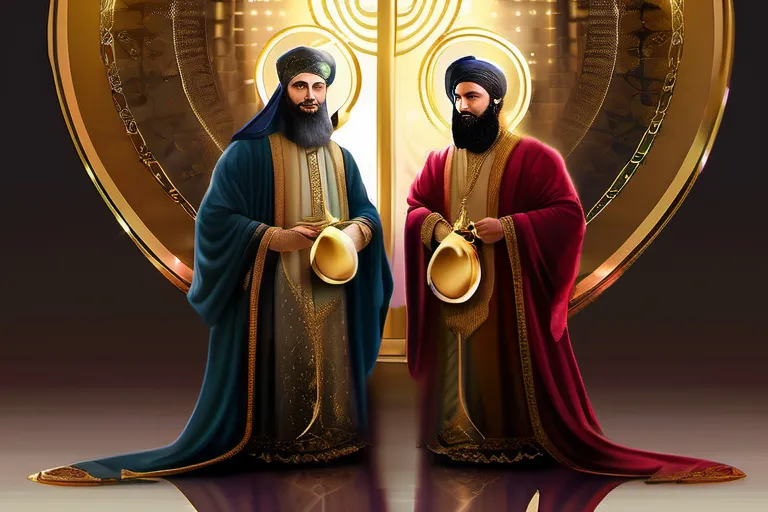Exploring the Lives and Reigns of the Four Rightly Guided Caliphs
Delve into the lives, reigns, and accomplishments of the four Rightly Guided Caliphs who led the Muslim community after the Prophet Muhammad’s demise. Learn about their contributions to Islam and how they shaped the early Islamic state.
The Life and Reign of Abu Bakr
The Rightly Guided Caliphs: A Comprehensive Guide explores the lives and reigns of these four pivotal figures who shaped early Islamic history. The journey begins with Abu Bakr, the first caliph, whose life was a testament to leadership, courage, and faith in the face of immense challenges.
Imagine for a moment, a small merchant from Makkah named Abu Bakr, whose name means ‘father of red camels.’ His conversion to Islam under the guidance of Muhammad (peace be upon him) was a turning point not just in his life but in the destiny of an entire civilization. As Muhammad’s close companion and confidant, Abu Bakr was more than just a witness; he was a living embodiment of the Prophet’s teachings.
When it came time to choose a successor, the community turned to Abu Bakr as naturally the leader due to his wisdom, piety, and unwavering commitment. The election process was simple yet profound: Muhammad had laid down the path for leadership through consultation (shura), and so the people elected their first caliph in a gesture of unity that would echo throughout history.
Abu Bakr’s reign was marked by military campaigns, but these were not merely battles; they were struggles to protect the nascent Muslim community. The Ridda Wars, or the Wars of Apostasy, tested his resolve and leadership skills. These conflicts were less about expanding territory than consolidating a fragile unity among the tribes that had pledged allegiance to Islam.
Through his decisions, Abu Bakr demonstrated strategic acumen. He appointed Uthman ibn Affan as governor of Syria due to Uthman’s reputation for fairness and competence. This decision showcased Abu Bakr’s wisdom in selecting capable leaders who could represent the caliphate with honor.
More than a ruler, Abu Bakr was a unifying figure. His reign laid down principles that would guide future caliphs: justice, consultation, and a commitment to the welfare of the community. In many ways, his leadership can be seen as a bridge between Muhammad’s prophetic mission and the establishment of an Islamic state.
The Life and Reign of Umar ibn al-Khattab
The life and reign of Umar ibn al-Khattab, the second Rightly Guided Caliph, stand as a testament to his transformative leadership during Islam’s early years. How could one man, born into poverty in Mecca, rise to such heights of power and influence? His journey is not just a tale of personal triumph but also a pivotal moment in the history of an expanding empire.
Umar’s election as caliph marked a new era of stability and growth for the Muslim community. But how did he manage this transition so seamlessly, especially after the tumultuous times under Abu Bakr? Umar’s reputation for fairness and wisdom was well-earned; his decisions often balanced strict justice with practical mercy.
Umar’s military campaigns were not merely conquests but strategic expansions that secured the frontiers of Islam. His famous saying, ‘The sword does not lie,’ aptly summarizes his belief in the power of armed might to spread and protect the faith. Yet, under Umar’s leadership, these campaigns also brought about a remarkable period of peace with Christian communities across Syria and Palestine.
Politically, Umar’s decisions had lasting impacts. He introduced a complex system for managing the vast territories of the empire, ensuring that local governors were both accountable and respected. His role in expanding the Islamic empire was not just through military means but also by establishing efficient administrative structures that continue to influence governance today.
Perhaps most importantly, Umar’s legacy lies in his ability to unite a diverse community under a common purpose. He faced numerous challenges, from internal political strife to external threats, yet he managed to keep the Muslim state on a steady course of growth and development. How did he do it? By setting an example of humility and dedication to justice, qualities that Umar embodied throughout his reign.
Umar ibn al-Khattab’s reign was a blend of military prowess, political acumen, and a deep commitment to the welfare of his people. His leadership during this crucial period laid the groundwork for future caliphs and set a standard for governance that has been studied and admired throughout history.
As we delve deeper into Umar’s life and reign, it becomes clear why he is revered as one of Islam’s greatest leaders. The story of his rise to power and the manner in which he governed is not just a narrative of events but a living testament to the principles that guide Muslim leadership today.
How can we learn from Umar’s example? What lessons does his life hold for us in an age of complex challenges and global responsibilities?
The Life and Reign of Uthman ibn Affan
Imagine a time when the sands of Arabia were bustling with change and destiny, where the voice of Uthman ibn Affan echoed through the corridors of power as the third Rightly Guided Caliph. Born into the noble Quraish tribe, Uthman’s journey from a respected companion to the leader of an expanding empire was marked by both triumph and controversy. How did he rise to such a pivotal position in Islamic history?
Uthman’s background was one of privilege and piety. He was a cousin of Prophet Muhammad (PBUH) and his wife, Ayesha, which gave him a unique place among the early Muslims. His election as caliph in 644 CE was seen by many as a logical step, given his wealth, literacy, and standing within the community. Yet, it was not without its challenges. The path to his caliphate was paved with debates and discussions, much like choosing the right stones for a mosaic—each one contributing to the intricate design of Islamic governance.
During Uthman’s reign, the Islamic empire continued to expand, reaching into areas that would later become parts of modern-day Turkey, Greece, and even Egypt. His role in consolidating this vast territory was crucial. Uthman emphasized legal standards and administrative efficiency, ensuring that justice was served uniformly across diverse regions. However, his reign also faced its share of turbulence. The growing discontent among certain tribes and the increasing number of non-Arab converts brought about significant social and political issues.
Uthman’s decisions to standardize the Quran, making it easier for new Muslims to learn and recite, was a landmark achievement. It symbolized his commitment to unity within the expanding Muslim community, much like binding together disparate strands to create a strong rope. Yet, as time passed, these very achievements became the source of conflict, leading to his eventual downfall in 656 CE.
The story of Uthman ibn Affan is a testament to the complexities faced by leaders in shaping an empire. His reign was a blend of consolidation and crisis management, a balance that many still strive to understand today. As we reflect on his life and legacy, it’s hard not to wonder how different the history of Islam might have been under his leadership.
The Life and Reign of Ali ibn Abi Talib
The Life and Reign of Ali ibn Abi Talib: Delve into the life of Ali ibn Abi Talib, the fourth Rightly Guided Caliph. Born in the same cradle as the Prophet Muhammad himself, Ali’s background was steeped in deep devotion and familial ties to Islam’s founder. His election as caliph marked a pivotal moment, following a period of turmoil and controversy over succession.
The choice of Ali reflected both his piety and his standing within the Muslim community. He was seen not just as a cousin but also as a loyal and brave warrior who had fought in numerous battles to protect Islam’s early days. His ascension raised questions about leadership, justice, and the nature of governance itself. How would he balance the expectations of a community that revered him while navigating complex political landscapes?
Ali’s reign was marked by challenges, both internal and external. He faced opposition from various factions within Arabia who were wary of his rule or sought to assert their own authority. This period saw the emergence of the first major split in Islam: the conflict between Sunni and Shia Muslims. Ali’s role as a mediator and arbitrator highlighted his wisdom but also placed him at the center of this burgeoning divide.
Ali’s commitment to justice was legendary, even among his critics. He is remembered for his fairness, often resolving disputes with words rather than force. Yet, despite his efforts, he found himself embroiled in a series of conflicts that ultimately led to his assassination. His life became a paradox—braving countless battles yet falling victim to internal strife.
The legacy of Ali ibn Abi Talib extends far beyond his caliphate. He is revered as the fourth Imam by Shia Muslims and celebrated for his unwavering faith among Sunnis. His life serves as a testament to the complexities of leadership, the importance of justice, and the enduring challenges faced by those who lead with integrity.
As we explore Ali’s reign, we are confronted with a leader whose legacy continues to shape Islamic thought and practice. How would you have handled the responsibilities that came with such an esteemed position? The path of Ali ibn Abi Talib is one of both glory and tribulation, offering profound lessons for leaders everywhere.
The Legacy of the Rightly Guided Caliphs
The Legacy of the Rightly Guided Caliphs: Explore the enduring legacy of these revered leaders who have served as role models for Muslim governance throughout history. How do their contributions continue to shape Islamic law, society, and leadership?
Imagine a grand tapestry woven with threads of wisdom and justice – this is the legacy of the Rightly Guided Caliphs. Each one of them has left an indelible mark on Islamic civilization, influencing every aspect from legal frameworks to social structures. How can we understand their impact without delving into the intricate details of their reigns?
Consider Ali ibn Abi Talib, whose legacy as a caliph is deeply intertwined with his broader role in Islam. His reign saw significant developments in governance and law, setting precedents that continue to resonate today. But what about the other three Rightly Guided Caliphs – Abu Bakr, Umar, and Uthman?
Abu Bakr’s leadership was marked by a profound sense of unity amidst internal strife. His quick thinking during the Ridda Wars demonstrated his strategic acumen and commitment to Islam. How did he manage to consolidate power and ensure stability in such turbulent times? Umar ibn al-Khattab, often referred to as “Umar the Great,” was known for his administrative brilliance and fair judicial decisions. His reforms reshaped society and laid the foundation for future Islamic governance. Can you imagine a legal system where every decision is made with the welfare of the people at heart?
Uthman ibn Affan’s caliphate saw the expansion of the Muslim empire under his watchful eye, but also faced significant challenges, including the compilation of the Koran. His efforts to standardize and preserve the holy book were crucial for future generations. How did Uthman balance the complexities of empire-building with the preservation of religious texts?
These Rightly Guided Caliphs have not only shaped the early Islamic state but continue to serve as benchmarks for just governance. Their contributions in establishing principles of justice, equity, and unity remain relevant today. As we reflect on their lives and reigns, we ask ourselves: How can modern leaders draw inspiration from these historical figures? In what ways can their legacies inform our approach to leadership and governance?
The Challenges Faced by the Rightly Guided Caliphs
The challenges faced by the Rightly Guided Caliphs were indeed like navigating through a stormy sea, where every wave threatened to capsize their small but significant vessel. How did these early leaders manage such turbulent waters? One can only wonder if they felt the weight of the world on their shoulders as they sought to maintain unity within the Muslim community.
Internal conflicts were like quicksand, pulling them down into the depths of division and dissent. The succession from Abu Bakr to Umar, Uthman, and finally Ali was not without its controversies. These internal disputes threatened to break apart what was supposed to be a unified front for Islam. How did they navigate these treacherous waters? Were their decisions guided by wisdom or were they swayed by the currents of power?
External threats, on the other hand, were like giant ships approaching from afar, ready to crush any flimsy defenses. The Byzantine and Persian Empires loomed large, presenting constant challenges. How did these caliphs balance their defense with offense, ensuring both the security of their borders and the spread of Islam? Were they always at war or were there moments when diplomacy and peace took precedence?
Navigating these difficulties required a delicate balancing act, much like walking on a tightrope. They had to be firm in their leadership while also being flexible enough to adapt to changing circumstances. The question remains: how did they maintain the trust of the people during such volatile times?
In many ways, these challenges were not just about surviving but thriving under pressure. It was a test of their character and the principles that guided them. Were they merely rulers or were they leaders who genuinely cared for the well-being of their subjects? The answers to these questions reveal much about the true nature of leadership during this pivotal period in Islamic history.
Conclusion
 Understand the significance of the Rightly Guided Caliphs in the development of Islam, and appreciate their enduring legacy as models of leadership for Muslims throughout history.
Understand the significance of the Rightly Guided Caliphs in the development of Islam, and appreciate their enduring legacy as models of leadership for Muslims throughout history.











